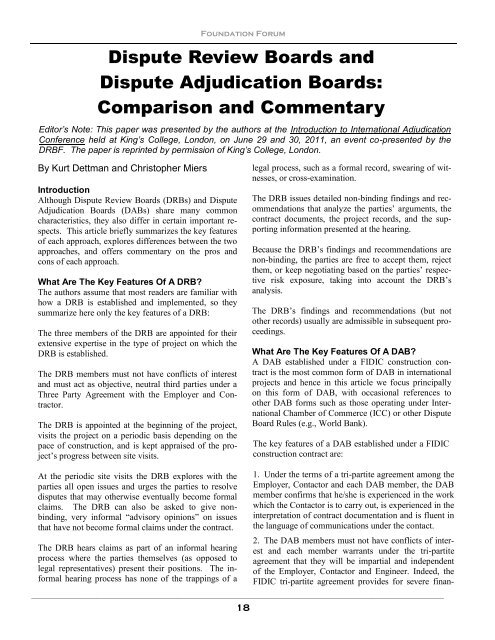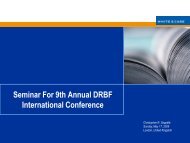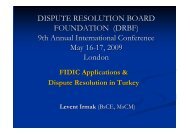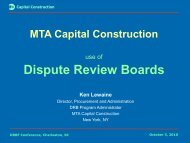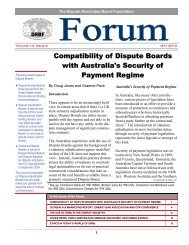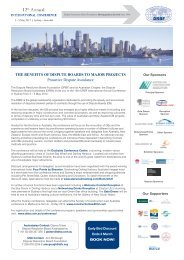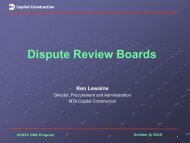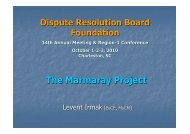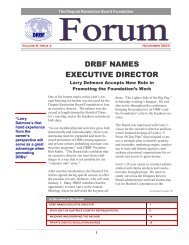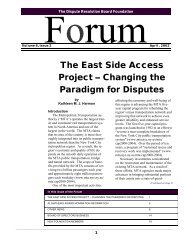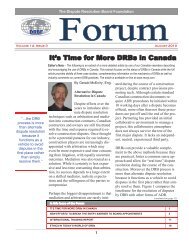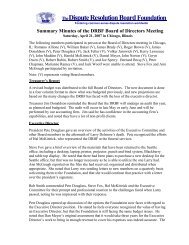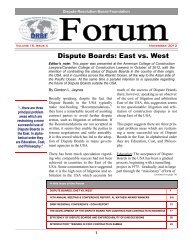DRBs Down Under - Dispute Resolution Board Foundation
DRBs Down Under - Dispute Resolution Board Foundation
DRBs Down Under - Dispute Resolution Board Foundation
Create successful ePaper yourself
Turn your PDF publications into a flip-book with our unique Google optimized e-Paper software.
<strong>Foundation</strong> Forum<br />
<strong>Dispute</strong> Review <strong>Board</strong>s and<br />
<strong>Dispute</strong> Adjudication <strong>Board</strong>s:<br />
Comparison and Commentary<br />
Editor’s Note: This paper was presented by the authors at the Introduction to International Adjudication<br />
Conference held at King’s College, London, on June 29 and 30, 2011, an event co-presented by the<br />
DRBF. The paper is reprinted by permission of King’s College, London.<br />
By Kurt Dettman and Christopher Miers<br />
Introduction<br />
Although <strong>Dispute</strong> Review <strong>Board</strong>s (<strong>DRBs</strong>) and <strong>Dispute</strong><br />
Adjudication <strong>Board</strong>s (DABs) share many common<br />
characteristics, they also differ in certain important respects.<br />
This article briefly summarizes the key features<br />
of each approach, explores differences between the two<br />
approaches, and offers commentary on the pros and<br />
cons of each approach.<br />
What Are The Key Features Of A DRB<br />
The authors assume that most readers are familiar with<br />
how a DRB is established and implemented, so they<br />
summarize here only the key features of a DRB:<br />
The three members of the DRB are appointed for their<br />
extensive expertise in the type of project on which the<br />
DRB is established.<br />
The DRB members must not have conflicts of interest<br />
and must act as objective, neutral third parties under a<br />
Three Party Agreement with the Employer and Contractor.<br />
The DRB is appointed at the beginning of the project,<br />
visits the project on a periodic basis depending on the<br />
pace of construction, and is kept appraised of the project’s<br />
progress between site visits.<br />
At the periodic site visits the DRB explores with the<br />
parties all open issues and urges the parties to resolve<br />
disputes that may otherwise eventually become formal<br />
claims. The DRB can also be asked to give nonbinding,<br />
very informal “advisory opinions” on issues<br />
that have not become formal claims under the contract.<br />
The DRB hears claims as part of an informal hearing<br />
process where the parties themselves (as opposed to<br />
legal representatives) present their positions. The informal<br />
hearing process has none of the trappings of a<br />
legal process, such as a formal record, swearing of witnesses,<br />
or cross-examination.<br />
The DRB issues detailed non-binding findings and recommendations<br />
that analyze the parties’ arguments, the<br />
contract documents, the project records, and the supporting<br />
information presented at the hearing.<br />
Because the DRB’s findings and recommendations are<br />
non-binding, the parties are free to accept them, reject<br />
them, or keep negotiating based on the parties’ respective<br />
risk exposure, taking into account the DRB’s<br />
analysis.<br />
The DRB’s findings and recommendations (but not<br />
other records) usually are admissible in subsequent proceedings.<br />
What Are The Key Features Of A DAB<br />
A DAB established under a FIDIC construction contract<br />
is the most common form of DAB in international<br />
projects and hence in this article we focus principally<br />
on this form of DAB, with occasional references to<br />
other DAB forms such as those operating under International<br />
Chamber of Commerce (ICC) or other <strong>Dispute</strong><br />
<strong>Board</strong> Rules (e.g., World Bank).<br />
The key features of a DAB established under a FIDIC<br />
construction contract are:<br />
1. <strong>Under</strong> the terms of a tri-partite agreement among the<br />
Employer, Contactor and each DAB member, the DAB<br />
member confirms that he/she is experienced in the work<br />
which the Contactor is to carry out, is experienced in the<br />
interpretation of contract documentation and is fluent in<br />
the language of communications under the contact.<br />
2. The DAB members must not have conflicts of interest<br />
and each member warrants under the tri-partite<br />
agreement that they will be impartial and independent<br />
of the Employer, Contactor and Engineer. Indeed, the<br />
FIDIC tri-partite agreement provides for severe finan-<br />
———————————————————————————————————————————————————<br />
18


